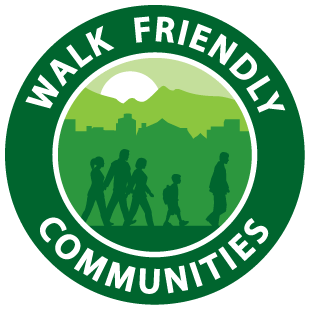Community Highlights
Asheville is designated as a Silver-level community due to its outstanding enforcement efforts and varied evaluation techniques. The city also has great sidewalk design standards and ordinances that promote dense, mixed-use development. Highlights of Asheville’s application include:
- In 2014, Asheville’s City Council began allocating funding each year for building new sidewalks in neighborhoods. The City’s Multimodal Transportation Commission worked with City Staff to develop a Neighborhood Sidewalk Policy which includes criteria for identifying and prioritizing neighborhood sidewalk projects.
- A citywide review of speed limits resulted in reducing posted speeds from 35 mph to 25 mph on 50 miles of the City’s streets.
- Open Streets Asheville builds momentum for active transportation throughout the community with events that open streets for people and encourage residents to consider alternate forms of transportation. Thousands of attendees take to the streets each year to walk, bike and enjoy the community.
- City staff, volunteers, and community partners have used a variety of tools, including Walkability Checklists and the Pedestrian Road Safety Audit Guidelines, to evaluate roadways and potential projects. A Walkability Checklist was used by a group of volunteers from Downtown Asheville Residential Neighbors, Keller Williams, and the Asheville Downtown Association to develop a Walkability Study for Downtown Asheville. Volunteers photographed and ranked problems with sidewalks in the downtown area and presented the study to the Downtown Commission and the city’s Transportation Department.
- The Asheville Police Department has a Traffic Safety Unit that includes five officers and one sergeant. The Unit conducts monthly enforcement operations, which average 15 hours of staff time and result in over 20 citations. The city also conducts district-specific crash analyses that are translated into enforcement plans. The enforcement plan activities are then evaluated at the end of a six-month period.
- In 2009, Asheville started an annual counting program for bicycles and pedestrians. Volunteers receive training before they spread out to conduct two hour counts at 15 locations. The city has also begun including pedestrian counts in contracts for intersection traffic counts. In 2017, eight years into the program, the City performed counts at 42 intersections. Working with the French Broad River MPO, the City purchased permanent counters to expand their program.
- Asheville maintains a GIS-based inventory of sidewalks and curb ramps. Missing segments are prioritized annually using criteria in Asheville’s Pedestrian Plan. The top scoring projects are then evaluated based on their ability to connect to the existing sidewalk network and whether there is existing sidewalk on one side of the street. The final projects are assessed for construction feasibility and cost, and then the available funds are allocated to top ranking projects.
- Asheville’s development density bonuses are designed to promote sustainability and affordability. Criteria for density bonuses include the provision of site amenities, proximity to transit, and short distance to high frequency transit line. The city also has good parking policies downtown and allows for accessory dwelling units in all residential zones.
- All new pedestrian signal installations in Asheville must include accessible countdown signals.

